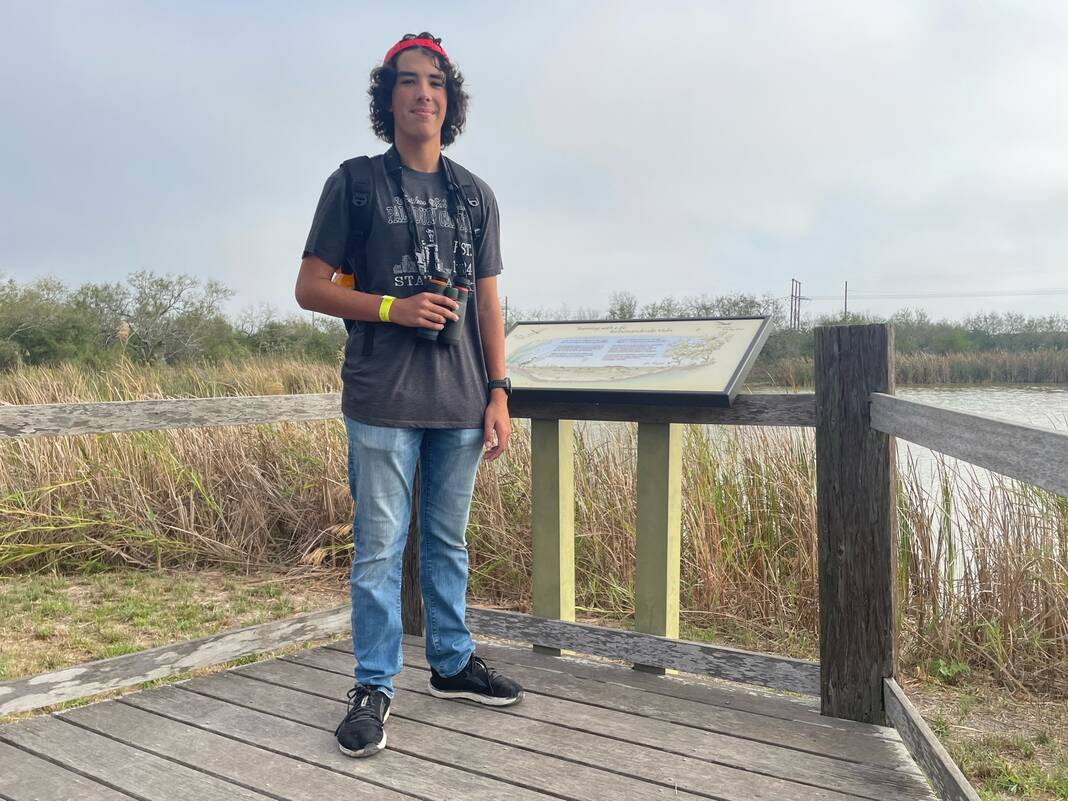
WESLACO — Ryan Rodriguez scans the pond through the binoculars, searching the logs and the cattails for any rarities.
A new bird is the goal of any avid bird watchers, but this morning he finds the lake at Estero Llano Grande State Park filled most entirely by black-bellied whistling dusks.
“Most of them are still sleeping,” says Ryan, 15.
It’s mid-morning at Estero Llano Grande. On his way to the park from his home in McAllen the sun had shown bright in a cloudless sky. Now a pale shroud of mist and cloud have cooled the air, which is favorable for birding, but …
“It’s gonna burn off,” he says.
Ryan has become a familiar face among nature enthusiasts both here and throughout the United States. On any given day, you might see him wandering around Bentsen-Rio Grande Valley State Park with his Canon EOS Rebel SL2 with a 100-400 lens shooting pictures of hook-billed kites, scissor-tailed flycatchers and winter wrens. Or the National Butterfly Center zooming in on guava skippers or Mexican bluewings or malachites.
Ryan has been a nature lover his entire life. His parents have taken him and his siblings camping and hike in such places as Yosemite National Park in California and Palo Duro Canyon State Park in Texas. However, he himself is the family birder and he has no clear memory of how that started. The story from others is that when he was only two or three years old, he found a Sibley birding guide. From that singular incident sprang a fine trajectory of learning on a road less traveled that will take him far. He considers more these days a future that will focus on nature, perhaps a life in research.
As a home-schooled sophomore who takes classes through an online school, he has the liberty and flexibility to pursue his passion. His postings on various online forums for nature enthusiasts reveal a refreshing eloquence and a passion for nature.
“Seven hook-billed kites. SEVEN!!!” he writes about a visit to Bentsen late last year.
“OK,” he continues. “Now this is where most of you would think I’m crazy. And you’d be right. But not in that way. There really were at least seven birds today. I’ve pretty much written an essay, so sit back, relax, and enjoy.”
And so he does, explaining he arrived at the park “pauraque early” in reference to a bird that camouflages itself as tree bark. And Ryan doesn’t have to see a pauraque to know it’s there.
“Their winter calls are the best,” he writes of his Bentsen visit last year.
“I heard one growl for the first time,” he continues. “Other night birds were Great horned and Eastern screech owls. It was evident the mimids had heard my tawny collared nightjar whistling, which I do by habit now, and were interested in this strange new bird.”
He later explains it’s a “term for the taxonomic family which includes mockingbirds, thrashers, and catbirds.”
Responses to these short narratives reveal connections with people throughout the United States and beyond, from scientists and aging northerners, amateurs and experts many years older that Ryan.
“That’s a wrap on Hawk Watch for 2022,” writes Jeffrey Fortescue. “Thanks to the count master, John Kaye, and also Ryan Rodriquez … who was there often and taught me a lot as well.”
This morning his parents have dropped him off at Estero Llano Grande for a Texas Master Naturalist orientation. But that won’t be for a few hours, and he knows the birds and trails of this park very well.
“Let’s go to Alligator Lake,” he says, leading the way on gravel pathways, his backpack with Gatorade and first-aid kit slung over his back.
He quickly breaks into another narrative about an alligator that has been seen recently with tape over its mouth. He expresses incredulity and anger about the cruelty and who would do that and why. Attempts to capture it have as yet proven unsuccessful.
He has memories along every tail and pond, it seems.
“I was standing here,” he says, stopping on the bank of Alligator Lake.
“There was a baby alligator. I got closer to it and took a picture. Then I saw an eight-foot alligator looking very angry.”
A brief laugh, and then … “I sort of ran.”
We come across a patch of thick scrub and says, “Ever seen a pauraque? I think I could find one here.”
His eyes search through the shadows and quickly nods: “There’s one of them here at the base of this tree. See the golden colored feathers?”
I observe vaguely a pattern that seems out of place.
“I saw rabbit walk up and step on a pauraque. I’ve never seen a rabbit run that fast.”
Now he directs his attention toward the bank of a pond and a bird sitting on a branch.
“There’s a night heron over there,” he says. “It’s a nocturnal heron.” Pause, then, “The water is very low here. It’s very controlled here. If it’s low, they make it low.”
“They” probably refers to members of his circle of nature experts with whom he has a surprising familiarity.
Perhaps more people in high places will become familiar with Ryan as he pursues grand challenges to preserve, investigate and celebrate the natural world.




